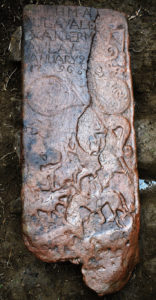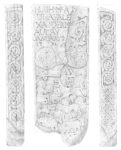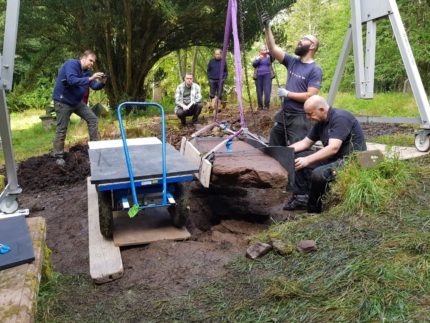 Archaeologists have discovered a rare Pictish symbol stone that was reused as a headstone in the 18th century. It was found during a survey of an early Christian church site near Dingwall in the Scottish Highlands. It had been identified as a likely cross slab dating to the late 8th century. An inscription squeezed in on the top left of the front face reads: “Hugh McAulay Alexander McAulay January 2 1796.”
Archaeologists have discovered a rare Pictish symbol stone that was reused as a headstone in the 18th century. It was found during a survey of an early Christian church site near Dingwall in the Scottish Highlands. It had been identified as a likely cross slab dating to the late 8th century. An inscription squeezed in on the top left of the front face reads: “Hugh McAulay Alexander McAulay January 2 1796.”
Cross slabs are named for a design element — an intricately carved cross — found on at least one side. There are around 350 recorded and documented Pictish symbol stones. There are only around 50 carved Pictish cross slabs known. There is no cross on the front of the newly discovered stone (which technically makes it the back, or reverse of the stone; the cross side is the obverse). When the back of the slab is cleaned and if the carvings are sufficiently extant, experts will be able to confirm whether this is a cross slab.
Only about half of the height of the stone survives. Archaeologists think it was originally over six feet tall; there’s just over a meter (3.2 feet) left, likely from the top part. There are carvings on both sides — archaeologists saw as much when the stone was lifted, but the coating of soil obscured the imagery.
John Borland, of Historic Environment Scotland and president of the Pictish Arts Society, said: “The discovery of the top half of a large cross slab with Pictish symbols is of national importance.
“The find spot – an early Christian site in Easter Ross – is a new location for such sculpture so adds significant information to our knowledge of the Pictish church and its distribution,
“This new discovery will continue to stimulate debate and new research.”
 Recycled Pictish stones have been found before. They were reused as boundary stones and lintels, in portals and as headstones. This one has some characteristic Pictish abstract designs including the Z-rod and Double Disc, but it has Celtic interlace motifs as well. This is typical of later symbol stones which syncretized the decorative traditions and included carved pictorial references to Biblical characters, see the Nigg Church Pictish cross-slab, for example.
Recycled Pictish stones have been found before. They were reused as boundary stones and lintels, in portals and as headstones. This one has some characteristic Pictish abstract designs including the Z-rod and Double Disc, but it has Celtic interlace motifs as well. This is typical of later symbol stones which syncretized the decorative traditions and included carved pictorial references to Biblical characters, see the Nigg Church Pictish cross-slab, for example.
The stone was raised on Thursday and will be cleaned and conserved. Eventually it will be exhibited in a museum, ideally in the Highlands.
